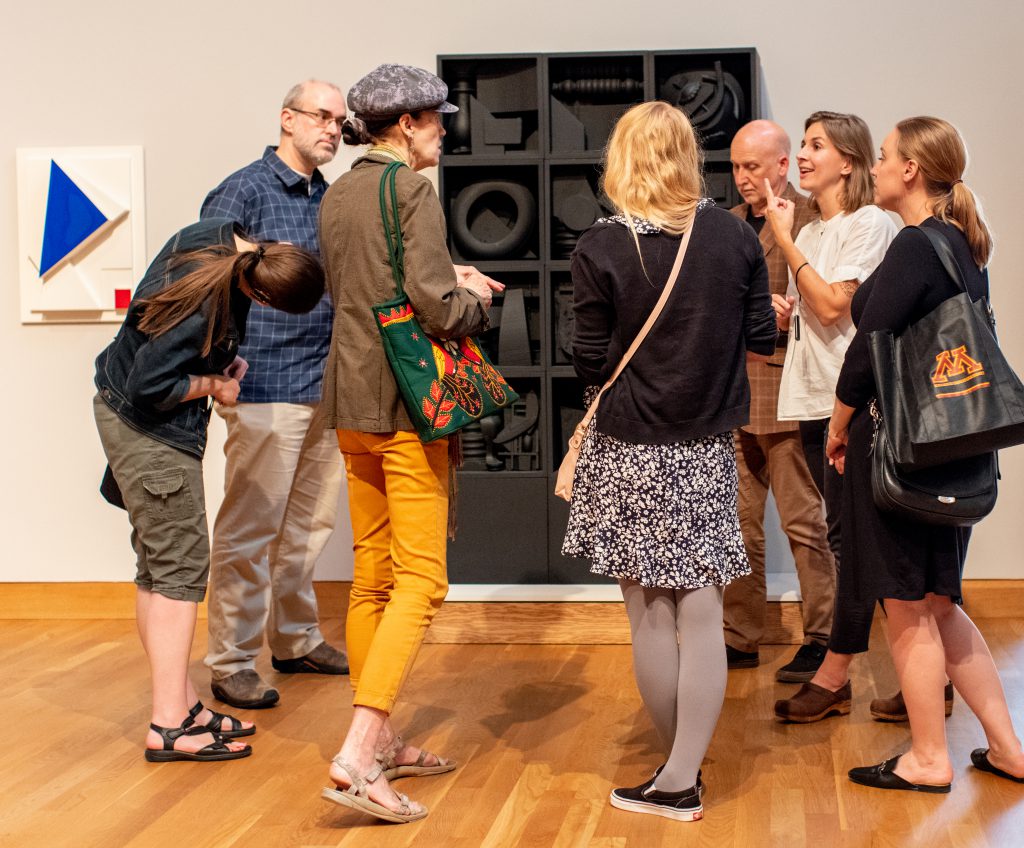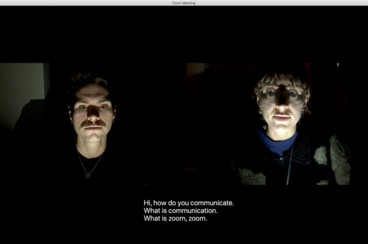
FEATURED ESSAY
Every experience is a multi-sensory experience, whether we actively perceive it as such or not. Changes in sensory input, likewise, change our composite experience of the world. Even so, people with sensory loss are rarely consulted during the planning process of collective experience-creation; not included in the development of those experiences, people with sensory loss feel left out of them altogether. As the Weisman’s Director of Education, I am part of a collaborative team working to reimagine the way the museum engages with people who have sensory loss. Through a recent grant awarded by the Institute of Museum and Library Services (IMLS), this team will design and create more responsive, representational strategies to serve people with sensory loss, specifically working with people in the low/no vision and Deaf/hard of hearing communities.
Thanks to an IMLS CARES Act Grant award of $200,000, we are able to reimagine existing museum programs, build upon past processes, ideate together and co-create new operational processes and programming. We hope that by conducting deep internal reviews of the ways we work, the accessibility of our spaces, and how we approach program creation at the Weisman, we will grow as we learn. Inviting people who have low/no vision and/or are Deaf/hard of hearing into this work with us is crucial to creating an authentically welcoming space for these community members.
I’m excited to share what we’re building on, what we’re working on right now, and future plans of the Arts Access: Beyond the Senses (AABS) initiative. Our team’s goal is to change the “normative rules,” generally set by “able-bodied” museum staff, for how someone with sensory loss can fully experience and engage art in a museum context. The AABS initiative of Weisman Art Museum (WAM) intends to move beyond purely adaptive accommodations to create holistic strategies for museum engagement that center inclusive design principles and expand access to digital resources, gallery experiences, and public programs to serve those who have low/no vision and are Deaf/hard of hearing. This process will be guided by leaders, innovators, and visitors in those communities.
Accessible programming often works from a normative ideal. For example, touch tours are a common offering, and they can be enjoyable, but they tend to divert the visitor to a very limited portion of available museum exhibits, which are seldom the main, seasonally featured exhibits. Touch tours also often require visitors to wear gloves, which doesn’t really allow a person to feel the object fully. What’s more, such experiences usually need to be booked weeks, if not months, in advance. The problem with this type of programming is that it still asks people with disabilities to do the work to get to normative experiential ideals. WAM is collaborating with key partner organizations that bring vital accessibility expertise to the table to fundamentally rethink principles and processes for developing programs and resources with a more inclusive approach.
The University of Minnesota-based Disability Resource Center (DRC) and Center of Applied and Translational Sensory Science (CATSS) are key university partners; Vision Loss Resources (VLR) will help develop an inclusive and comprehensive program as a key community collaborator in the initiative. We’ve also formed an accessibility advisory committee to help guide the pedagogy around museum exhibitions and program development overall. WAM’s accessibility advisory committee includes University faculty and staff and community members who have disabilities and/or are particularly attuned to the needs and interests of disabled people. This accessibility advisory committee includes: museum professional and qualitative researcher, Leslie Henry Kadish, Executive Director of CATSS; Peggy Nelson, PhD, professor and researcher at CATSS; Gordon Legge, PhD; multimedia artist and curator of academic programs at Krannert Art Museum, Liza Sylvestre; PhD candidate and artist/researcher with CATSS, Walter Wu (Yueh-Hsun Wu); Associate Director of Programs for Vision Loss Resources, Susan Anderson; and Access Assistance Coordinator at the UMN Disability Resource Center, Sarah Kahn. Together, this team will design a program for the Weisman, based on their expertise working with these target communities, research in the field, qualitative feedback methods, and personal experience. To ensure benchmarks are assessed and met throughout the program development process, WAM is partnering with Kate Haley Goldman at HG&Co, who will work with the team as an evaluation consultant.
The Arts Access: Beyond the Senses initiative will create products and activities in the following three areas:
- Needs assessment: convene a project workgroup of partners to meet monthly and an access advisory committee of community members, experts in the field and artists; conduct a needs assessment of the museum and programs as specifically related to people with sensory disabilities, create a prioritized plan of actionable goals, conduct research and use focus groups to gather data for reporting and sharing best practices;
- Training: train museum staff and volunteers how to effectively work with low/no vision communities and make museum resources accessible, even in times of required pandemic precautions;
- Resource development: train WAM staff, students, and volunteers in providing verbal description and develop a suite of in-person and digital resources utilizing verbal description methodologies; create verbal description tours for group visits and self-guided verbal description audio tours. Host a symposium examining visually dominant museum work, exhibitions, interpretation, and programs in conjunction with a major museum exhibition that examines “visual art” and visual engagement.
The issue of museum access for sensory-impaired visitors was explored by Weisman Art Museum artist-in-residence, Liza Sylvestre, during her four-month residency in the museum’s Target Studio for Creative Collaboration in 2018. During her residency, Sylvestre, a person with hearing loss, worked with University of Minnesota researchers from the Center of Applied and Translational Sensory Science (CATSS). The AABS Initiative will build on Liza’s original project at WAM’s Target Studio. As a person working and living with sensory disabilities, Sylvestre laid the groundwork for expanded research, planning, prototyping and evaluation of adaptive resources for people with disabilities and their overall effectiveness during her residency with WAM.

Sylvestre’s work at WAM explored how participants with sensory loss currently experience and engage with the museum building, collection, and resources, including the available accommodations, which have been generally designed by (and for) people with sight and hearing. The feedback she gleaned during her residency illuminated the very narrow access currently provided for sensory-impaired visitors and led to the development of a new partnership between the WAM and the nonprofit organization, Vision Loss Resources (VLR) in Minneapolis. Vision Loss Resources (VLR) provides training, classes, social activities and support groups for people with vision loss living in the Minneapolis-Saint Paul area.
Expansion of this work, in the face of a public health crisis, will raise the museum’s level of service to these audiences, address the needs and challenges of populations and organizations in the sensory disability community, and provide specific response to the challenges COVID-19 has presented with the following intended results:
- Increase access: Build trust between WAM and low/no vision communities through inclusive and accessible program development to increase the likelihood these visitors have successful virtual and in-person experiences at the museum. Increase utilization of the museum’s exhibits and resources by people with sensory disabilities and the service organizations that support them.
- Provide training: Raise the comfort and competency level of staff and tour guides who interact and engage with low/no vision audiences.
- Share methodology with peers in the museum field: Relevant research will be shared on a local, regional, and national scale via conferences and convenings to assist other institutions who serve low/no vision communities. Research will be published on the Weisman’s website and submitted to museum-practice journals.
In continuing and expanding this necessary work, WAM strives for a more inclusive museum experience. Ideally, the museum will also find ways to make all its exhibits accessible in more meaningful ways. As humans, we’re very good at categorizing and labeling, but too often those classifications are reductive rather than expansive, and not rich enough to encompass the wide variety of lived experiences. We tend to view people as either able-bodied or disabled, and design assistive products designed for one category or the other accordingly. In fact, capability varies continuously. Nothing, no sensory experience, exists in isolation.
With this initiative, we are looking to create tools to enrich accessibility, beyond existing adaptive accommodations, and to design more inclusive programs holistically, by listening to our partners and working directly with the people we want to serve. Working collaboratively in this way, we are confident these new tools will enhance cultural and educational opportunities for people with sensory disabilities, and improve their personal experiences at the museum. But we’re also aiming to influence, more broadly, the pedagogy of museum exhibition and program development, overall. This is an initiative that, from its conception, centers and celebrates a diversity of experiences, bodies, and cultures.
Links and Related Information
- Liza Sylvestre's Sensory Loss Symposium (2018 incubator project at the Weisman's Target Studio for Creative Collaboration)
- "Reflections on the Sensory Loss Symposium" by Liza Sylvestre
- Target Studio for Creative Collaboration: Collaboration Incubator Program
- Diversity, Equity, Accessibility, and Inclusion at WAM: A (Re)New(ed) Collaboration


